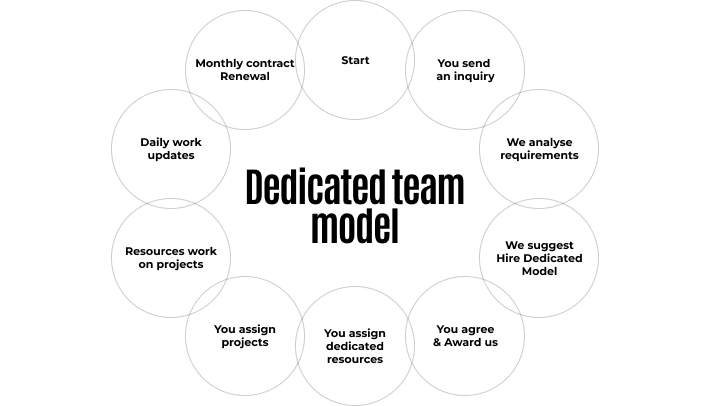The companies may need to move their digital product development from in-house to outsource for various reasons. They include the necessity to empower the team, lack of technical skills in the in-house team and others. We have reviewed these reasons more thoroughly in one of the previous articles.
This article will go further into the area of outsourcing and its payment models. It describes the particular points of each cooperation type and defines what option suits your company’s needs.
A pricing model for development services is a part of a contractual agreement between two companies. These models are called to help both sides of the agreement get the most of profit. And below, we describe most of the benefits each approach brings.
Companies often tend to outsource when they need to shift their operations overseas and reduce the cost of development or find skilled specialists to empower the team.
What are the common pricing models?
Commonly, the way the company will pay for a solution depends on the method its resources (time, manpower and money) are distributed for completion of the development cycle.
Some companies provide the choice among three, others among four types of models:
- dedicated team;
- time and material;
- fixed price;
- pay per hour.
Dedicated team
Such a model is used when the company orders the entire team for its purposes. The dedicated development team communicates with the customer straightforward and stays bound to one project from the very beginning. The development price is calculated based on the hourly rates of a particular developer and the time spent on this job. Besides monthly payments on these rates, the bill can include additional fixed costs, such as taxes or bank transfer charges.
The team sometimes can become even more than the simple performer of tasks, as it has to follow the corporate culture of the customer. To empower the team and in case the customer wishes to get a single person to deal with all communication – the team offers a qualified Project Manager. This person can become a true mediator and offer the unobvious solutions that optimize the project.
A unified team has one prominent benefit – they reduce the overall cost of product development. By setting the team from the start, the company should not search for additional professionals or replace them in the middle of the development. The load and working pace can be predicted, based on the experience of the completion of the previous projects. After getting the first results, outsourcing will definitely be cheaper than the hiring of the local team, the reasons for which we described earlier.

When to select a dedicated team model?
It can become a great option for gross projects lasting for a long time. Commonly such concepts have rather ambiguous requirements to the final solution and scope that can change with time because of their complexity. The customer should personally manage the project and create the paths for its development or get a professional PM. Such team composition helps to avoid miscommunication and lost ideations.
Pros and Cons of a dedicated team model
Benefits you can get by applying this model:
- The whole team is combined for one project from its initialisation till launch and further possible maintenance.
- The cost of the project is reduced compared to in-house teams or a bunch of freelancers.
- High effectiveness is based on deep exposure of the team to the project.
- The customer personally manages people, resources and flow, unless hires the PM.
- The project scope and tasks completion are rather flexible.
- All communication over the project is performed directly with the team.
Nevertheless, the company can face some difficulties:
- Not the best choice for short-term projects.
- Additional management by PM will cost extra funds, without which the company should bear all the risks themselves.
- The time needed for the project completion can not be calculated with ease at once and can vary due to the growing number of features marked for implementation.
Time and material
It is based on the particular number of resources needed to complete the project and satisfy the initial goals. The company pays only for the materials applied. Deep and constant coordination of the project by the customer can ensure the viability of such an approach. They personally decide whether to continue the development of the particular items or not. This approach is great for a fast-changing market and responsive to any trends.
When having raw concepts of the future project the decision-maker can define the order and the value of each task that should be done. This approach can be applied for redesigning life projects and their testing in the market. Under such conditions, theories testing can be performed faster and cheaper. That brings great agility in terms of budget and specifications within the development course.

When to select the time and material?
It can make the best work for middle and large in time and range development cycles. With a vague scope that can change among the development process, it is rather effective to introduce timely changes in the product. This model allows controlling the budget thoroughly. When having an unproven idea or testing the market, such an approach can save time and money.
Pros and Cons of a time and material payment model
Benefits you can get include:
- The customer can pay for the tasks or features that should be done in the stated period.
- The project can be started very quickly without long initiation and the team composing.
The negative points are the following
- The customer can not grasp the entire budget of the project due to the varying number of tasks.
- Management is totally laid down on the customer which means more time is needed to puzzle out the project details and introduce timely changes.
Fixed-price
The payment model is used for projects developed with a limited and strict budget and small plausibility of changes that can be introduced in the process. It requires deep planning and a specified statement of works to calculate the price for the project. As the result, it can be used on projects that provide low business risks and are developed by experienced teams.
As the price is outlined from the start, the layout of the future product is predefined as well. This approach defines a clear development schedule that can be easily followed by the team. The absence of necessity to analyze the current situation on the project reduces all external management to the lowest rate. In some cases, it is enough to participate the accountable Project Manager, state the necessary scope and pay the one-time bill to get the developed solution.

When to select a fixed price?
It is a great solution for projects with a defined scope and period. They mostly are short term or medium in length. The customer avoids managing the flow of the development course themselves, as the list of future functions is predefined from the start. The team of developers should only follow the timelines and produce the result. All possible changes can be introduced only after the completion of the fixed scope.
Pros and cons of fixed price model
The benefits include:
- The overall control over the final budget from the development initialization.
- Small external management is needed from the client.
- The preliminary plan of the development cycle stages is underlined together with the functional scope.
- PM can empower the coordination of the project.
- No hidden payments in the middle of the process flow.
The drawbacks are the following:
- To be realistic, the estimate should be deep and done by the experienced team.
- The final quality of the project can suffer due to the tight timeline.
- In case the customer may wish to add new features, they lead to an additional circle of negotiations and funding.
- Preliminary calculations may take a lot of time, so the project initialization starts with a delay.
Pay-per-hour
This payment mode is one of the most straightforward. It allows getting the digital product ready for the business asap. Time becomes money without any figurative way of speech. Concerning that not each hour in the full day can be paid for, such an approach provides flexibility and variable control over the budget.
When the scope of the project is vague or requires relevant reactions to changes in the market, the company can lower the risks of failure by paying for the hours spent solely for the purposes of this project.
The complementary control over the work done is the ownership of the customer. In case support is needed, the appointed manager can take this responsibility to allow communication with a single person. Under any unpredictable conditions, it is possible to end the project at any stage and pay only for the applied time.

When to select pay-per-hour
Pay per hour model is great for small and medium projects requiring a limited number of participants. In the case of really big projects, it is better to apply the dedicated team model. Besides, it is a nice choice when the customer wishes to understand how much they are paying for the work done. And no matter how fast the project ends. When the scope is undefined or requires constant clarifications, the project requires strong management as well.
Pros and cons of this model
The benefits include:
- It helps to avoid risks in projects with vague scope.
- The development flow may be stopped or postponed at any moment.
- It is very simple for accounting.
Negative moments:
- It is difficult to calculate the entire budget from the development start.
- The deliverable period can not be clearly defined.
- Can require additional funding for complicated and long-term tasks or problem-solving.
- The client should take total control and manage the project flow.
Make your selection with the payment methods complementary table
Check the table with the arranged points crucial for a company trying to choose the proper pricing model.

Knowing the weak and strong points of each pricing model you can choose the one suiting your future project. To make the choice clearer, define the particular goal you wish to get from such a cooperation. The preliminary stages can include:
- market and target audience analysis;
- business scalability plan;
- financial planning;
- forms of distribution;
- risks you can tolerate or wish to avoid.
In case of an outstanding and totally new product, try building an MVP to test it under live conditions. How to do so without losses, find in one of the previous articles.
Minding an idea but hesitating about what option to choose to be great for your business? Contact us, and our appointed manager will help you to reach your goal.


















